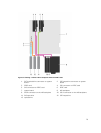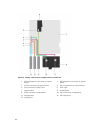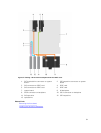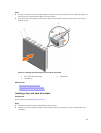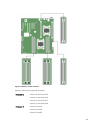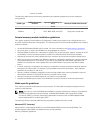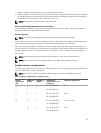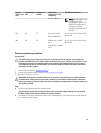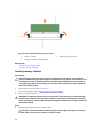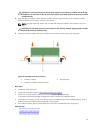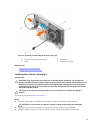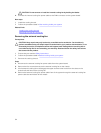
• Memory modules must be identical in size, speed, and technology.
• DIMMs installed in memory sockets with white release levers must be identical and similar rule applies
for sockets with black release levers. This ensures that identical DIMMs are installed in matched pairs -
for example, A1 with A2, A3 with A4, A5 with A6, and so on.
NOTE: Advanced ECC with Mirroring is not supported.
Memory optimized (independent channel) mode
This mode supports SDDC only for memory modules that use x4 device width, and the mode does not
impose any specific slot population requirements.
Memory sparing
NOTE: To use memory sparing, this feature must be enabled in the System Setup.
In this mode, one rank per channel is reserved as a spare. If persistent correctable errors are detected on
a rank, the data from this rank is copied to the spare rank and the failed rank is disabled.
With memory sparing enabled, the system memory available to the operating system is reduced by one
rank per channel. For example, in a dual-processor configuration with sixteen 4 GB dual-rank DIMMs, the
available system memory is: 3/4 (ranks/channel) × 16 (DIMMs) × 4 GB = 48 GB, and not 16 (DIMMs) × 4
GB = 64 GB.
NOTE: Memory sparing does not offer protection against a multi-bit uncorrectable error.
NOTE: Both Advanced ECC/Lockstep and Optimizer modes support Memory Sparing.
Sample memory configurations
The following tables show sample memory configurations for one and two processor configurations that
follow the appropriate memory guidelines.
NOTE: 1R and 2R in the following tables indicate single- and dual-rank DIMMs respectively.
Table 1. Memory configurations—single processor
System
Capacity (in
GB)
DIMM Size
(in GB)
Number of
DIMMs
DIMM Rank,
Organization, and
Frequency
DIMM Slot Population
4 4 1
1R, x8, 2133 MT/s,
1R, x8, 1866 MT/s
A1
8 4 2
1R, x8, 2133 MT/s,
1R, x8, 1866 MT/s
A1, A2
16 4 4
1R, x8, 2133 MT/s,
1R, x8, 1866 MT/s
A1, A2, A3, A4
8 2
2R, x8, 2133 MT/s,
2R, x8, 1866 MT/s
A1, A2
87



